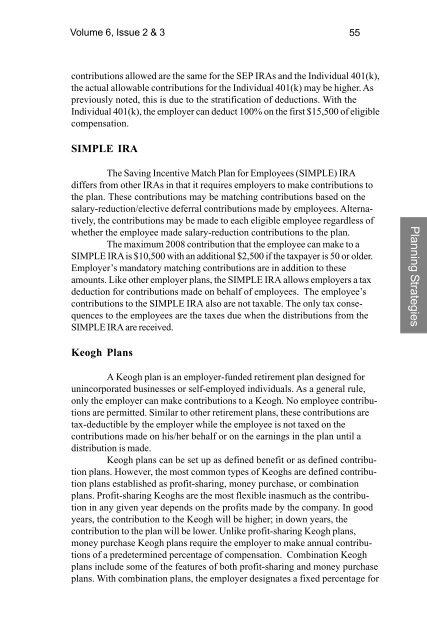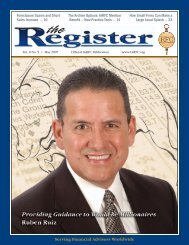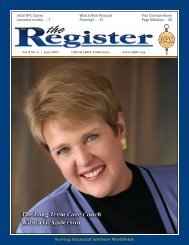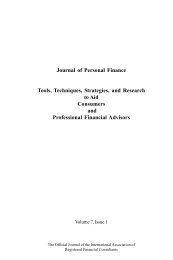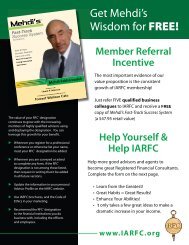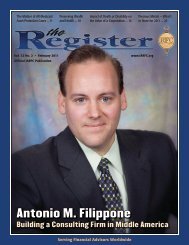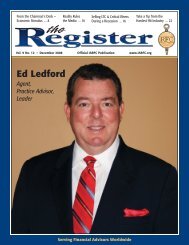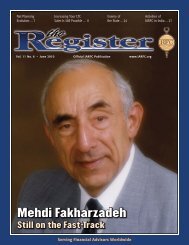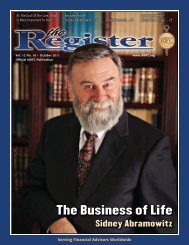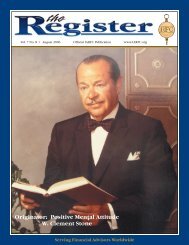3433-vol. 6 issue 2-3.pmd - iarfc
3433-vol. 6 issue 2-3.pmd - iarfc
3433-vol. 6 issue 2-3.pmd - iarfc
Create successful ePaper yourself
Turn your PDF publications into a flip-book with our unique Google optimized e-Paper software.
Volume 6, Issue 2 & 3 55<br />
contributions allowed are the same for the SEP IRAs and the Individual 401(k),<br />
the actual allowable contributions for the Individual 401(k) may be higher. As<br />
previously noted, this is due to the stratification of deductions. With the<br />
Individual 401(k), the employer can deduct 100% on the first $15,500 of eligible<br />
compensation.<br />
SIMPLE IRA<br />
The Saving Incentive Match Plan for Employees (SIMPLE) IRA<br />
differs from other IRAs in that it requires employers to make contributions to<br />
the plan. These contributions may be matching contributions based on the<br />
salary-reduction/elective deferral contributions made by employees. Alternatively,<br />
the contributions may be made to each eligible employee regardless of<br />
whether the employee made salary-reduction contributions to the plan.<br />
The maximum 2008 contribution that the employee can make to a<br />
SIMPLE IRA is $10,500 with an additional $2,500 if the taxpayer is 50 or older.<br />
Employer’s mandatory matching contributions are in addition to these<br />
amounts. Like other employer plans, the SIMPLE IRA allows employers a tax<br />
deduction for contributions made on behalf of employees. The employee’s<br />
contributions to the SIMPLE IRA also are not taxable. The only tax consequences<br />
to the employees are the taxes due when the distributions from the<br />
SIMPLE IRA are received.<br />
Planning Strategies<br />
Keogh Plans<br />
A Keogh plan is an employer-funded retirement plan designed for<br />
unincorporated businesses or self-employed individuals. As a general rule,<br />
only the employer can make contributions to a Keogh. No employee contributions<br />
are permitted. Similar to other retirement plans, these contributions are<br />
tax-deductible by the employer while the employee is not taxed on the<br />
contributions made on his/her behalf or on the earnings in the plan until a<br />
distribution is made.<br />
Keogh plans can be set up as defined benefit or as defined contribution<br />
plans. However, the most common types of Keoghs are defined contribution<br />
plans established as profit-sharing, money purchase, or combination<br />
plans. Profit-sharing Keoghs are the most flexible inasmuch as the contribution<br />
in any given year depends on the profits made by the company. In good<br />
years, the contribution to the Keogh will be higher; in down years, the<br />
contribution to the plan will be lower. Unlike profit-sharing Keogh plans,<br />
money purchase Keogh plans require the employer to make annual contributions<br />
of a predetermined percentage of compensation. Combination Keogh<br />
plans include some of the features of both profit-sharing and money purchase<br />
plans. With combination plans, the employer designates a fixed percentage for


